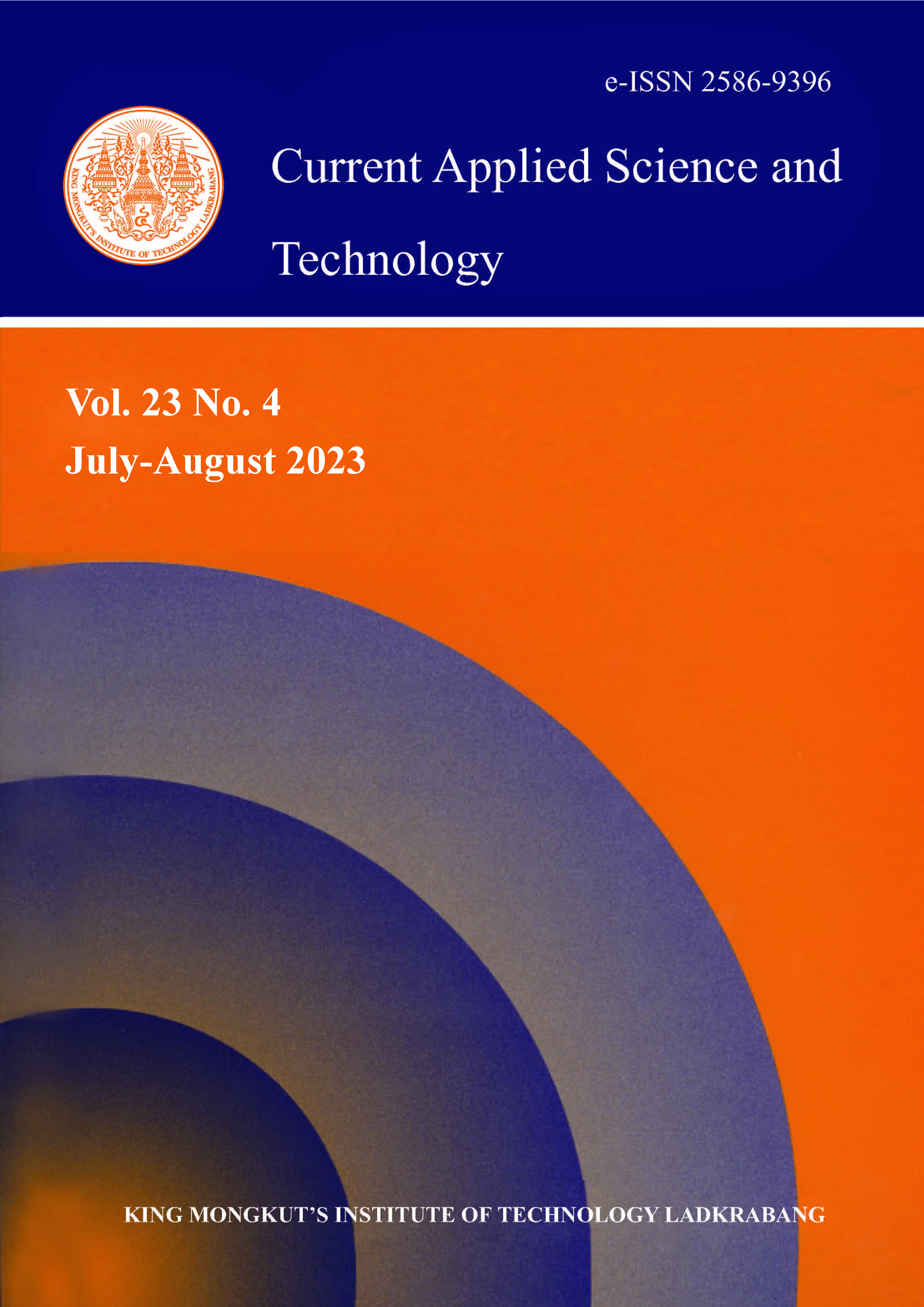Effects of Hydroxypropyl Methylcellulose Fiber Amounts and Aspect Ratios on Properties of Biodegradable Composites Prepared from Thermoplastic Starch
Main Article Content
Abstract
Because of the low tensile properties and high hydrophilicity of thermoplastic starch (TPS), this research was focused on improving its characteristics through the addition of the natural cellulose fiber, hydroxypropyl methylcellulose (HPMC). Different TPS composites reinforced with HPMC fibers were compounded using an internal mixer and were shaped using a compression molding machine. The effects of HPMC fiber content and aspect ratios were examined. It was found from infrared spectra that the wavenumbers of the O-H stretching of TPS polymer clearly shifted to lower wavenumber with the incorporation of HPMC fibers, which indicated new hydrogen bond formation. Moreover, a significant increase of maximum stress and elastic modulus of TPS/ HPMC fiber composites was detected. A clear drop in moisture uptake was also found when HPMC fibers were added into the TPS polymer matrix. In addition, scanning electron microscopy and thermogravimetric analysis were used to characterize several TPS composites. Biodegradability for various composites was also determined.
Keywords: biodegradable polymer; composite; fiber; thermoplastic starch
*Corresponding author: Tel.: (+66) 2329 8400 ext. 228
E-mail: jutarat.si@kmitl.ac.th
Article Details

This work is licensed under a Creative Commons Attribution-NonCommercial-NoDerivatives 4.0 International License.
Copyright Transfer Statement
The copyright of this article is transferred to Current Applied Science and Technology journal with effect if and when the article is accepted for publication. The copyright transfer covers the exclusive right to reproduce and distribute the article, including reprints, translations, photographic reproductions, electronic form (offline, online) or any other reproductions of similar nature.
The author warrants that this contribution is original and that he/she has full power to make this grant. The author signs for and accepts responsibility for releasing this material on behalf of any and all co-authors.
Here is the link for download: Copyright transfer form.pdf
References
BeMiller, J. and Whistler, L., 2009. Starch: Chemistry and Technology. 3rd ed. New York: Academic Press.
Ma, X., Yu, J. and Kennedy, J.F., 2005. Studies on the properties of natural fibers-reinforced thermoplastic starch composites. Carbohydrate Polymers, 62(1), 19-24, DOI: 10.1016/j.carbpol.2005.07.015.
Kaewtatip, K. and Thongmee, J., 2012. Studies on the structure and properties of thermoplastic starch/luffa fiber composites. Materials and Design, 40, 314-318, DOI: 10.1016/j.matdes.2012.03.053.
Ramírez, M.G.L., Satyanarayana, K.G., Iwakiri, S., de Muniz, G.B., Tanobe, V. and Flores-Sahagun, T.S., 2011. Study of the properties of biocomposites. Part I. Cassava starch-green coir fibers from Brazil. Carbohydrate Polymers, 86(4), 1712-1722, DOI: 10.1016/j.carbpol.2011.07.002.
Prachayawarakorn, J., Ruttanabus, P. and Boonsom, P., 2011. Effect of cotton fiber contents and lengths on properties of thermoplastic starch composites prepared from rice and waxy rice starches. Journal of Polymers and the Environment, 19(1), 274-282. DOI: 10.1007/s10924-010-0273-1.
Prachayawarakorn, J., Chaiwatyothin, S., Mueangta, S. and Hanchana, A., 2013. Effect of jute and kapok fibers on properties of thermoplastic cassava starch composites. Materials and Design, 47, 309-315, DOI: 10.1016/j.matdes.2012.12.012.
Prachayawarakorn, J.and Hanchana, A., 2017. Effect of neem wood sawdust content on properties of biodegradable thermoplastic acetylated cassava starch/neem wood sawdust composites. Starch - Stärke, 69(3-4), DOI: 10.1002/star.201600113.
Burdock, G.A., 2007. Safety assessment of hydroxypropyl methylcellulose as a food ingredient. Food and Chemical Toxicology, 45(12), 2341-2351, DOI: 10.1016/j.fct.2007.07.011.
Ghadermazi, R., Hamdipour, S., Sadeghi, K., Ghadermazi, R. and Asl, A.K., 2019. Effect of various additives on the properties of the films and coatings derived from hydroxypropyl methylcellulose-A review. Food Science and Nutrition, 7(11), 3363-3377, DOI: 10.1002/fsn3.1206.
Chen, J., Zheng, M., Tan, K.B., Lin, J., Chen, M. and Zhu, Y., 2022. Development of xanthan gum/hydroxypropyl methyl cellulose composite films incorporating tea polyphenol and its application on fresh-cut green bell peppers preservation. International Journal of Biological Macromolecules, 211, 198-206. DOI: 10.1016/j.ijbiomac.2022.05.043.
Vieira, A.C.F., Fonseca, J.D.M., Menezes, N.M.C., Monteiro, A.R. and Valencia, G.A., 2020. Active coatings based on hydroxypropyl methylcellulose and silver nanoparticles to extend the papaya (Carica papaya L.) shelf life. International Journal of Biological Macromolecules, 164, 489-498, DOI: 10.1016/j.ijbiomac.2020.07.130.
Song, J., Feng, H., Wu, M., Chen, L., Xia, W. and Zhang, W., 2020. Preparation and characterization of arginine-modified chitosan/hydroxypropyl methylcellose antibacterial film. International Journal of Biological Macromolecules, 145, 750-758, DOI: 10.1016/j.ijbiomac.2019.12.141.
da Silva, M.N., Fonseca, J.D.M., Feldhaus, H.K., Soares, L.S., Valencia, G.A., de Campos, C.E.M. and Monteiro, A.R., 2019. Physical and morphological properties of hydroxypropyl methylcellulose films with curcumin polymorphs. Food Hydrocolloids, 97, DOI: 10.1016/j.foodhyd.2019.105217.
Jiang, Q., Zhou, W., Wang, J., Tang, R., Zhang, D. and Wang, X., 2016. Hypromellose succinate-crosslinked chitosan hydrogel films for potential wound dressing. International Journal of Biological Macromolecules, 91, 85-91, DOI: 10.1016/j.ijbiomac.2016.05.077.
Jiménez, A., Fabra, M.J., Talens, P. and Chiralt, A., 2012. Influence of hydroxypropylmethylcellulose addition and homogenization conditions on properties and ageing of corn starch based films. Carbohydrate Polymers, 89(2), 676-686, DOI: 10.1016/j.carbpol.2012.03.075.
Bilbao-Sainz, C., Bras, J., Williams, T., Sénechal, T. and Orts, W., 2011. HPMC reinforced with different cellulose nano-particles. Carbohydrate Polymers, 86(4), 1549-1557, DOI: 10.1016/j.carbpol.2011.06.060.
Shao, X., Sun, H., Zhou, R., Zhao, B., Shi, J., Jiang, R. and Dong, Y., 2020. Effect of bovine bone collagen and nano-TiO2 on the properties of hydroxypropyl methylcellulose films. International Journal of Biological Macromolecules, 158, 937-944, DOI: 10.1016/j.ijbiomac.2020.04.107.
Bower, D.I. and Maddams, W.F., 1996. The Vibrational Spectroscopy of Polymers, 2nd ed. Cambridge: Cambridge University Press.
Pawlak, A. and Mucha, M., 2003. Thermogravimetric and FTIR studies of chitosan blends. Thermochimica Acta, 396(1), 153-166, DOI: 10.1016/S0040-6031(02)00523-3.
Hull, D. and Clyne, T.W., 1996. An Introduction to Composite Materials, 2nd ed. Cambridge: Cambridge University Press.
Gómez-Carracedo, A., Alvarez-Lorenzo, C., Gómez-Amoza, J.L. and Concheiro, A., 2003. Chemical structure and glass transition temperature of non-ionic cellulose ethers. Journal of Thermal Analysis and Calorimetry, 73(2), 587-596, DOI: 10.1023/A:1025434314396.






